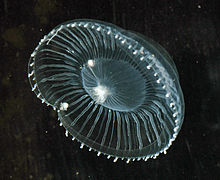|
Aequoreidae
Aequoreidae is a family of hydrozoans, sometimes called the many-ribbed jellies or many-ribbed jellyfish.[2][3] There are approximately 30 known species found in temperate and tropical marine coastal environments.[4] Aequoreids include Aequorea victoria, the organism from which the green fluorescent protein gene was isolated.[5] PolypsOnly the polyp stages of Aequorea species have been observed.[6] The colonies are covered with chitinous periderm and can be either prostrate or erect with weak or sympodial branching.[6] Young hydranths possess hydrothecae with a closing structure called operculum,[6] which consists of several relatively long triangular folds that meet together in the centre when a disturbed polyp contracts.[6] Because the operculum is quite fragile, hydrothecae of old polyps usually have only a small chitinous collar remaining.[6] Comparatively large cylindrical gonothecae are attached to the colony with a thin peduncle.[6] Commonly only one medusa develops in each gonotheca.[6] MedusaeMature aequoreid medusae are diverse in shape, from lens-like to conical, and in size.[4] The smallest, Aequerea parva is only 0.6 cm in diameter, while the largest, Rhacostoma atlanticum, can reach 40 cm in diameter.[4][6] The medusae of most species are between 5 and 15 cm in diameter.[4] GeneraAequoreidae includes the following genera:[1]
See alsoReferencesWikimedia Commons has media related to Aequoreidae. Wikispecies has information related to Aequoreidae.
|
||||||||||||||||||||||||
Portal di Ensiklopedia Dunia
